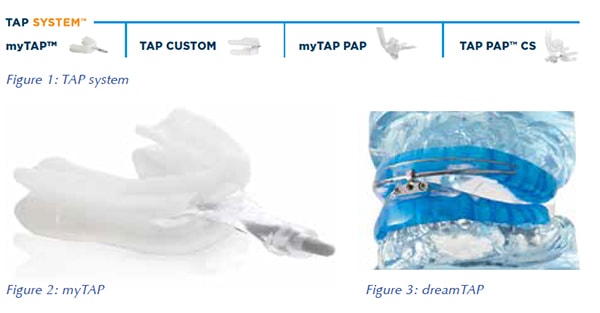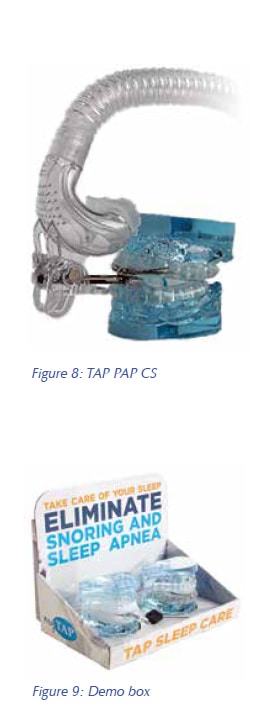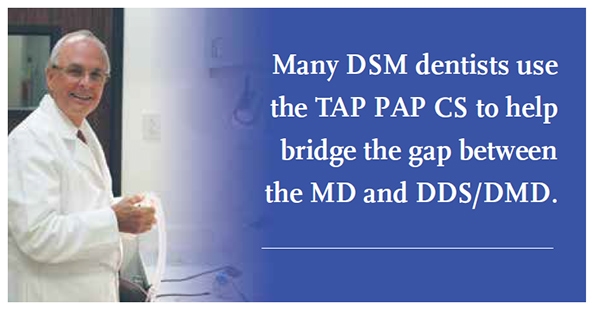 In 1992, an ENT surgeon referred a patient diagnosed with Sleep Related Breathing Disordered (SRBD) to me. This patient was non adherent with CPAP at a pressure of 18. Her sleep physician stated that since she had “failed CPAP” and was not a surgical candidate, her only option was to go to “this dentist who might have a solution”. Within a week, she received the only device available at the time, a Tongue Retaining Device (TRD). She died two weeks later in her sleep of cardiac arrest.
In 1992, an ENT surgeon referred a patient diagnosed with Sleep Related Breathing Disordered (SRBD) to me. This patient was non adherent with CPAP at a pressure of 18. Her sleep physician stated that since she had “failed CPAP” and was not a surgical candidate, her only option was to go to “this dentist who might have a solution”. Within a week, she received the only device available at the time, a Tongue Retaining Device (TRD). She died two weeks later in her sleep of cardiac arrest.
 Several lessons were learned from this:
Several lessons were learned from this:
- CPAP failures were common, even among the most severe patients treated by the most expert specialists.
- Dentists had the education and skills to treat this problem but needed better tools.
- The problem was a mechanical collapse of the pharynx which could be treated by the same principals used in cardiopulmonary resuscitation and anesthesia by “airway management”.
This began my quest to develop devices that would manage all levels of SRBD from mild snoring to severe obstructive sleep apnea syndrome. Airway Management’s story begins in 1994, when I built my first adjustable mandibular advancement device to treat obstructive sleep apnea. I had been very successful in my own clinical trials and decided to share the device with other dentists and physicians that were looking for an effective OSA treatment that patients would actually use every night.
By 1996, I obtained the necessary patents and regulatory clearance to market the device to professionals. The TAP 1 was launched and quickly adopted by the pioneering dentists in the fledgling dental sleep medicine market. It was the first adjustable device that was easy to titrate, comfortable and immediately effective for OSA patients. The overwhelmingly positive response from the DSM dentists made the TAP 1 a huge success thus changing the course of my professional career. I was able to turn an interest in airway management into a mission to improve the lives of patients with SRDB.
Over the next 20 years, I worked to constantly improve on the design of the appliance, and in May 2016, we introduced the 5th generation custom appliance, the dreamTAP.
I opened both Airway Labs to fabricate the appliances and act as my research and development department; and Airway Management to distribute to and support other dental laboratories and professionals worldwide. My philosophy has been to share the technology with those dental laboratories who want to offer our products which in turn has allowed us greater exposure and availability.
Today, Airway Management (AM) offers a robust product line that includes immediate delivery devices (myTAP), custom mandibular advancement devices (dreamTAP), CPAP masks (myTAP PAP) and combination therapy (TAP PAP CS). From predictor appliance to custom solutions, the TAP System has a range of advanced devices covering the full spectrum of SRDB.
Table of Contents
Design Principles
When I began to develop the TAP in 1994, I established three core design principles for the appliances that have guided all subsequent products; simple, durable, & patient friendly. These concepts are the foundation for every custom TAP appliance.
- Simple: Single point adjustment and custom fit trays
- Durable: Metal injection molded hardware with the finest dental alloys and high strength dental grade plastic trays.
- Patient Friendly: Easy to use and low-risk advancement mechanism
Over the years, the TAP appliances have been the subject of over 36 independent peer reviewed studies, the most of any other appliance. The studies proved that the custom TAP appliances consistently held up to CPAP and surpassed other mandibular advancement devices. After twenty years of studies, the conclusion is, it works.
The academic studies are excellent to prove the design principles but market acceptance by large organizations are another indication of the value of the TAP design in treating OSA. Airway Management is very proud to supply the TAP System to every branch of the US Armed Services, including the Veterans Administration, to ensure our service men and women are getting the best treatment wherever they are in the world. In addition, several of the most successful dental laboratories, in the USA and globally, manufacture TAP appliances for their clinicians.
 TAP Sleep Care System
TAP Sleep Care System
myTAP
The TAP System begins with the myTAP trial appliance (Figure 2). The myTAP allows the prescriber to provide same day treatment and immediate relief for their patients. The myTAP boasts the same midline advancement technology as the proven custom TAPs with an immense 21 mm range of advancement. This technology allows the prescriber to truly test the patient’s outcomes, compliance and acceptance of an oral appliance prior to prescribing a custom appliance.
TAP custom
The core product line in the TAP System is the custom TAP appliances, beginning in 1994 with the TAP 1. Since then, custom TAP has evolved into many versions for all types of patients and levels of SRDB including the TAP 3, TAP 3 Elite, and the most recent and all new dreamTAP.
dreamTAP
dreamTAP (Figure 3) is the 5th generation of the custom TAP appliance. After years of R&D, the dreamTAP was released in May 2016. For the casual observer, it looks similar to the previous versions of the TAP, but for the dentists treating OSA patients, it is a significant improvement.
 The core TAP design principles are clearly displayed in the dreamTAP including the single point adjustment, ease of use for patients and practitioners and the durable, custom trays.
The core TAP design principles are clearly displayed in the dreamTAP including the single point adjustment, ease of use for patients and practitioners and the durable, custom trays.
The most significant and obvious design change is the placement of the hardware. The hardware has been flipped placing the advancement mechanism on the mandible and the bars on the maxilla. All the hardware is facial to anterior teeth to maximize tongue space.
The durability has increased with the introduction of Chromium-Cobalt (Cr-Co) hardware. The advancement mechanism and hooks were redesigned before being tested for strength and tolerances as the design was fine tuned.
The dreamTAP is a very flexible treatment tool. Dimensionally, the lateral excursion in the anterior can be fabricated from about 4mm to 15mm. Airway Labs standard lateral excursion is approximately 15mm. The vertical height between the trays has been reduced to about 5mm. The clinician can prescribe the appliance with up to 15mm of vertical opening as determined by his/her preference.
One of the biggest advantages of the dreamTAP is the vast 15mm of horizontal protrusive range. The screw mechanism has a range of 5mm (Figure 4). You can extend this range with three hooks included with every appliance (Figures 5-6).
The bottom line is that the dreamTAP has the largest range of any oral appliance to treat OSA and SRDB. The dreamTAP is NOT technique sensitive. It is very flexible to ensure that wherever your starting position is, the dreamTAP can be adjusted in the practice to fit the patient’s needs.
Medicare vs Quick Release
Like all the of the custom TAP appliances, dreamTAP has received approval by PDAC (Pricing, Data, Analysis and Coding) and is accepted for reimbursement by Medicare.
The dreamTAP meets the requirements of PDAC by creating a hook design that is hinged and cannot be easily unhinged by the user. We use a 1.3mm bar to create the hinge with the hook. You must engage the hook on the side of the bar, where the diameter is reduced to accept the 1mm opening in the hook (Figure 7).
During R&D and patient testing, it became apparent there was a need to create an optional version that allowed the patients to quickly unhook while wearing the appliance. The “Quick Release” optional bar design was created to allow for this. The Quick Release version can be used with any insurance carrier not requiring PDAC listing for coverage.
 Quick Release dreamTAP uses a 0.8mm Cr-Co bar to engage the hook. The patient simply advances the mandible about 1.5mm to release the hook, while wearing the appliance. This eliminates any concerns about being “locked” in and makes it easier to insert and remove.
Quick Release dreamTAP uses a 0.8mm Cr-Co bar to engage the hook. The patient simply advances the mandible about 1.5mm to release the hook, while wearing the appliance. This eliminates any concerns about being “locked” in and makes it easier to insert and remove.
Options
Compliance tracking on custom TAP appliances is now available. We have partnered with Braebon to add the Dentitrac compliance device to our custom appliances. As insurers and government regulators attempt to increase compliance for OSA, this recording device will be extremely useful and possibly required in the future.
We will introduce a mouth shield to encourage nasal breathing, which can be added to the dreamTAP and is now available for the myTAP.
Blue colored trays will be an option in the 4th quarter of 2016 as supply becomes available.
Combination Treatment
Most studies have shown the TAP appliances to be very effective on their own, from simple snoring to moderate obstructive sleep apnea. To treat severe OSA, the clinician can use the TAP PAP CS, an add-on product to connect a dreamTAP (TAP 3 / TAP 3 Elite) to a nasal pillow CPAP mask (Figure 8).
This allows the professional to combine oral appliance therapy with CPAP, enabling most patients to reduce their CPAP pressures.
Many DSM dentists use the TAP PAP CS to help bridge the gap between the MD and DDS/DMD. It allows the dentist to discuss oral appliance therapy with the MD with a collaborative tangible device. Helping to create a positive working relationship between the branches of medicine needed to treat OSA.
Grow your DSM practice
Airway Management is committed to supporting our laboratory and dental customers. Our goal is education – the more information we can put in the hands of our customers to educate the patient, the more the patient will be fully informed about oral appliance therapy. AM offers two demonstration kits to help with just that – the dreamTAP Demo Kit and the TAP PAP CS Demo Kit. They contain both tangible demonstration models and informational brochures.
Because the majority of adults in the United States are either afflicted by or know someone afflicted by sleep disordered breathing, the normal dental practice has a large percentage of patients that need treatment. The simplest method to reach these patients is with the dreamTAP Demo Kit (Figure 9) in the waiting room. Also, a simple screening questionnaire such as the Epworth Sleepiness Scale can be given to each patient as part of their semi-annual dental visit, which can also spark conversation about TAP treatment solutions.
The TAP PAP CS Demo Kit is very effective in informing sleep physicians and medical professionals about the TAP appliance and combination therapy. Instead of simply pitting the oral appliance against the CPAP, the TAP PAP CS allows the best of both treatments, especially in a case where a patient is a CPAP intolerant or needs more therapy than CPAP alone.
 Summary
Summary
Overall, TAP Sleep Care is a systematic, comprehensive approach for managing Sleep Related Breathing Disorders (SRDB). Airway Management is extremely proud to be part of the solution; producing innovative oral appliances and other sleep therapies. We have made tremendous inroads in the dental sleep medicine market and strive to make oral appliance therapy more readily available in collaboration with our dental, medical and laboratory customers.
If you want to learn more about the TAP system (how to order, additional options, growing your DSM practice, and more), please register for our free 1 hour webinar by going to bit.ly/TAPwebinar.

